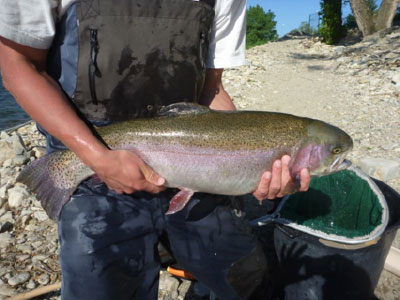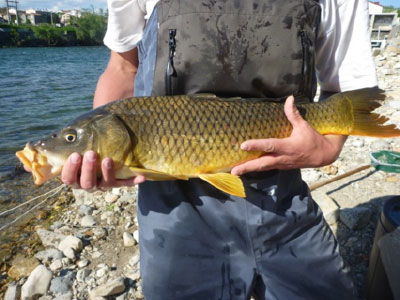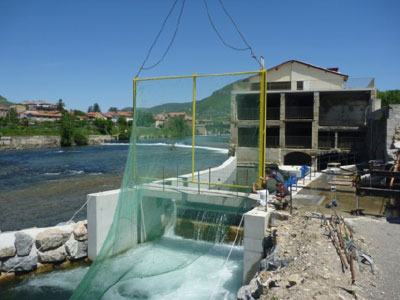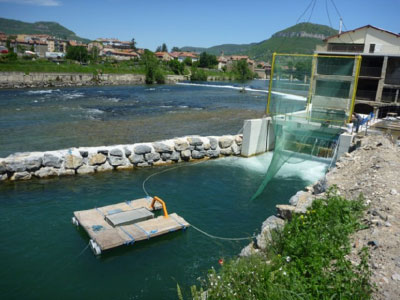
The specific features of the VLH turbogenerator unit make it on principle particularly respectful of fish populations. As we were aware of this advantage, we have centred the mechanical and hydraulic development of the VLH on an optimization of these intrinsic features.
Thus, from the beginning of the design by Pr. Kueny of the INPG (refer to professional partners) of the hydraulic profile of the wheel and distributor assembly, fish friendliness criteria to be optimised have been introduced and given a degree of priority over pure energetic performances.
We have thus tried to identify and quantify objective criteria enabling defining where and how a hydroelectric turbine can be fish friendly. We have for this purpose used existing scientific studies and especially those carried out by the USA Department of Energy (Idaho National Engineering and Environmental Laboratory) which has selected a list of criteria likely to qualify the degree of fish friendliness of a turbine.
At the end of the CFD studies, the values of the criteria obtained by the VLH turbo-generator unit have been compared with those retained by the laboratory.
As a summary, a comparison between the value of the retained criteria and the corresponding value obtained by the CFD simulation is disclosed hereafter.
| Criterion | Acceptability | VLH Value |
|---|---|---|
| Speed at the blade periphery | from 6 to 12 m/s | 4.5 to 8 m/s |
| Minimum encountered pressure | 69 kPa | 94 kPa |
| Maximum pressure gradient | 550 kPa/s | 80 kPa/s |
| Maximum speed gradient | 180 m/s/m | 10 m/s/m |
| Clearance between blade and mantle | 2.0 mm | 4.5 mm |
The VLH turbo-generator does not fulfil this last criterion. However, this search for a minimum clearance between blades and wheel mantle is only justified inasmuch as wheel crossing velocities are high and as the fish cannot use its directional power. The latter essentially depends on its swimming velocity as compared to flow velocities in the machine. Further, the new hydraulic design implemented from the end of 2009 incorporates a discharge ring and a hub of spherical shape, which enables to decrease the blade tip clearance and to maintain it whatever the blade opening position.
It should be reminded that the wheel crossing velocity in the VLH turbine is, in the case of the Millau prototype, 1.85 m/s at the maximum flow rate. It exceeds twice this value in the IDAHO laboratory machine (> 4 m/s). In these last conditions, the fish which is swept along into the hydraulic passage can only follow the flow threads, its travel path being imposed to it. If it is close to the wall of the runner discharge ring, it will have more difficulty to draw away from it than in the case of the VLH turbo-generator. Hence the relative importance of the blade/discharge ring clearance criterion. Live fish crossing tests have proven the relevance of this assumption (refer to fish friendliness test).
The analysis of the fish friendliness criteria shows that the VLH turbine is, from a qualitative point of view, far below the maximum values considered as acceptable (except for the blade end clearance criterion).
This study and its conclusions have been incorporated to the request for administrative authorization for the Millau demonstration site. They have been accepted by the relevant administrations. Due to the results of the downstream migration tests carried out in situ (refer to fish friendliness test), the Millau site is definitely exempt from downstream migration devices and fine rakes.
 The original features of the VLH provide it with extremely favorable environmental characteristics.
The original features of the VLH provide it with extremely favorable environmental characteristics.
Being the VLH unit submerged, its visual and noise impact is very low, thus making its implementation in urban environments very easy as in the case of the demonstration site located in the heart of the city of Millau, in the immediate proximity of dwellings and of the local camping ground.
However, the most interesting feature regarding the environmental impact of the VLH lies in its very low impact on fish migrations.
Such very specific characteristic led us to adopt a neologism able to sum up the concept in a single word: “fish-friendly”. Such neologism has been deposited and henceforth used in order to summarize the VLH ability to let fish migrate through its operating blades.
The VLH turbo-generator unit is the first hydroelectric turbine for which the fish friendly characteristics have been taken into account as basic data, from the origin of the equipment design.
In fact, its very large wheel diameter provides large spaces between guide vanes and between blades, enabling easy passing of all river fishes. Furthermore, the wheel rotation speed is very low (<40 rev/min) and the water flow speed inside the wheel remains below 2 m/s (comparable to that of a fish passing). Finally, the hydraulic passage is characterized by very low pressure variations.
All these objective data have already allowed, for the authorization of our Millau demonstration site, to avoid the installation of protection devices (fine screens, drain flows, etc.) preventing the downstream migration (passing of fishes from upper to lower waters) through the turbine wheel.
 Studies and tests under scientific supervision have been performed in collaboration with the “Office National de l’Eau et des Milieux Aquatiques” (ONEMA) on the Millau demonstration site, on the Frouard HPP on the Moselle river and then on the La Glacière site in Millau in order to confirm the downstream migration capacity of the VLH turbo-generator unit.
Studies and tests under scientific supervision have been performed in collaboration with the “Office National de l’Eau et des Milieux Aquatiques” (ONEMA) on the Millau demonstration site, on the Frouard HPP on the Moselle river and then on the La Glacière site in Millau in order to confirm the downstream migration capacity of the VLH turbo-generator unit.
Their excellent results rank the VLH as first among the most fish-friendly turbines tested up to the present day. Tests have also enabled to make modifications on the VLH to further improve its performance within this field.
6 test campaigns with live fishes have been carried out to demonstrate the fish-friendliness of the VLH and its very low impact upon the mortality of downstream migrating species crossing the turbine in operation, in April 2007 (smolts), December 2007-January 2008 (eels), February 2008 (smolts) October 2010 (eels) May 2013 (Big and small trouts) June 2013 (Big and small Carps)
October 2010 Live eels passage test in the Frouard HPP on the Moselle river
After a first series of tests with live eels carried out in 2008, outstanding results were obtained but some improvement of the VLH design were identified and should bring even better results. A second test was performed in 2010 on a VLH of 3rdgeneration in order to assess its final impact on eel migration.
The Frouard hydroelectric power plant is located on the Moselle river. This project has been disclosed in our previous Newsletter n°9.
The power plant comprises a 400-kW DN 4500 VLH under a 2.5-m head.
This latest-generation VLH is provided with a discharge ring having a spherical shape at the transition between the inlet cone and the actual discharge ring.
As in the first Millau tests, a first series of tests intended to try the equipment and the scientific protocol has been carried out in June 2010.
Once the equipment has been tested, the official tests were carried out in October.
The system of injection at several points and the recovery device are very similar to those used in the first 2008 tests in Millau on the Troussy VLH. After each specimen has been measured and inspected, the eels were distributed in batches and were directly introduced into the VLH immediately upstream of the guide vanes through a Ø 200 PVC tube.
The injection point could be displaced along the distributor spoke. 4 different points have been used in Frouard.
The recovery device was identical to that in Millau.
This 2nd test is the result of an international cooperation. A scientific committee has been formed, comprised of the best French specialists of hydroelectric turbine crossing, from the ONEMA, and of German and Belgian scientists. Further, a team of Polish specialists and members of the Commission internationale de protection de la Meuse et de la Sarre (CIPMS) have also attended the tests.
244 eels have been fished in Germany and transported to the Frouard site where they have been housed, with a water supply from the Moselle. The storage water parameters, such as temperature and dissolved oxygen rate, have been controlled.
The eels have been introduced by hand into the injection system.
They have then been recovered in the fish box installed in the floating pontoon connected to the outlet of the recovery net.
The recovered specimens have then been examined and placed back in their housing to remain under observation for 48h.
Outcome of the tests: After the tests and 48h of observation, no direct mortality has been observed for the 200 injected eels.
The survival rate is 100%
The VLH thus gives the proof that hydroelectricity is not incompatible with the protection of fishery species.
In order to simulate the downstream migration of Salmonids (Salmons, Sea Trouts, Rainbow Trouts) in their adult or juvenile stage (smolts for the salmons) we have used a sample of 700 Trouts which size is ranging from 20 cm up to more than 75 cm for the biggest. The test was performed on the latest commissioned VLH installed in Millau on the Tarn River in the south of France. The test protocol is similar to the one used before for eels and smolts. It consists of 3 different injection points on the turbine radius (Outer medium and inner).


For these particular tests 3 different opening positions of the blades were tested for each of the 3 injection points; 50%, 75 % and 100 % opening position.
Synthesis of the results of the tests (for a detailed test report go to …
The mortality ratio of the tested fishes of the VLH DN5000 with spherical stay ring and spherical hub installed on the River Tarn at the La Glacière HPP are the following:
 On the base of these unique and outstanding results, the VLH will be the hydroelectric turbine qualified as fish friendly by the French administration.
On the base of these unique and outstanding results, the VLH will be the hydroelectric turbine qualified as fish friendly by the French administration.